
Los Angeles, CA – February 27, 2024 – Today, the Los Angeles County Economic Development Corporation (LAEDC) proudly released its 2024 Economic Forecast. This comprehensive analysis, prepared by the LAEDC’s Institute for Applied Economics, delves into the national, state, regional, and local economic indicators, offering a nuanced understanding of economic trends in the aftermath of the COVID-19 pandemic and high inflation, and of the challenges and opportunities that lie ahead for Los Angeles County.
The forecast highlights the strength of the Los Angeles economy, noting its robust and resilient nature, allowing it to recoup job losses incurred during the pandemic. However, the 2024 Economic Forecast acknowledges that the recovery has not been uniform for everyone. With inflation subsiding and the Federal Reserve pausing rate hikes, there is a cautious optimism for the region’s economic future. Nevertheless, challenges such as the impacts of the SAG-AFTRA and WGA strikes, widening income inequality, a high cost of doing business, and an ongoing population decline threaten the economic vitality of Los Angeles County.
Identifying key challenges such as regional population decline, housing affordability, and the high cost of doing business, the 2024 Economic Forecast stresses the need for strategic regional investments crucial for spurring economic growth. The report provides recommendations for policies that will reduce costs in the region, improve the quality of life, and attract investment and thus encourage residents to remain in the area.
This year’s Economic Forecast was held today at the InterContinental LA Downtown to a crowd of more than 500 of Los Angeles’s top leaders in research, business, and economic development. The event featured panel discussions on the transition to clean energy, innovative solutions for housing and the importance of regional collaboration among local economic development organizations.
Below Are Some Highlights That Help Set the Stage For This Year’s Economic Forecast:
Regional Population Decline
Los Angeles faces a population decline, exacerbated by COVID-19 and remote work. By 2034, projections indicate a drop to under 9.5 million residents from a high of 10.2 million in 2018. This decline extends statewide, with major cities like San Diego and San Jose experiencing losses. Economic consequences include a shrinking labor force, reduced high-income earners, and declining entrepreneurialism and tax revenue. Policies addressing housing costs, demographics, and immigration, alongside investments like UCLA’s Research Park, offer potential solutions to spur economic growth despite population decline. Policy changes could attract investment and retain residents, mitigating further economic decline.
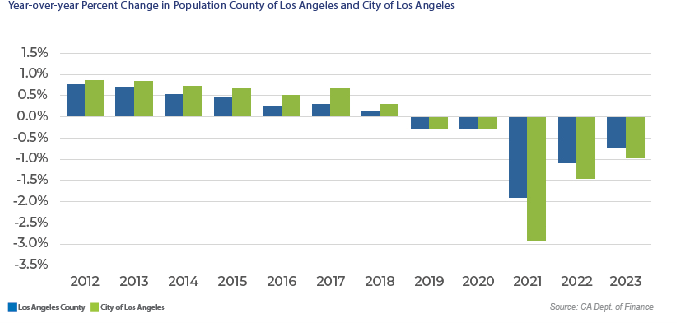
Housing Affordability
In Los Angeles, housing affordability has drastically declined, with only 11% of households able to afford a median-priced home, down from 31% a decade ago. Black and Latino communities are disproportionately affected. The majority of renters in Los Angeles County
(55.3 percent) are rent-burdened, meaning they pay more than 30 percent of their household income in rent and nearly 30 percent are severely rent-burdened, paying more than 50 percent of their household income. This precarious situation can exacerbate homelessness, which rose by 9-10% in 2023. High housing prices stem from insufficient housing supply and increased mortgage rates due to Federal Reserve actions. To address this, Los Angeles must innovate housing development, including faster ADU construction and reducing barriers to development, like impact fees, to moderate prices and improve affordability.
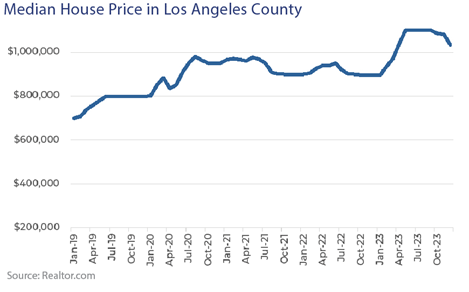
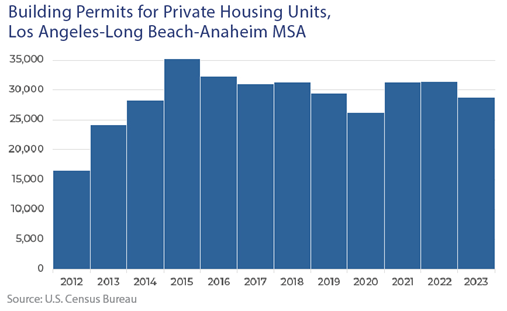
The High Cost of Doing Business:
High business costs in Los Angeles hinder economic growth. The Los Angeles-Long Beach-Anaheim Metropolitan Statistical Area ranks sixth highest in the US. Labor, energy, real estate, and tax expenses exceed national averages. Energy costs surged, attributed partly to state policies and climate challenges. Businesses face closures due to rising expenses, like restaurants hit by food and labor costs. Balancing cost reduction with worker support is vital, with potential solutions including energy infrastructure investments like the Hydrogen Hub.
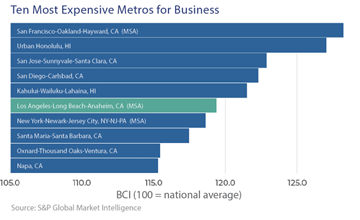
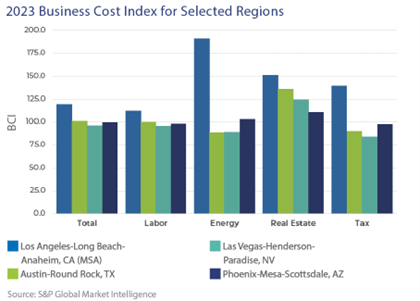
High Office Vacancy Rates Throughout the County
The pandemic caused high office vacancies in Los Angeles County, reaching 21.9% in Q4 2023, a new historic high. Challenges include decreased leasing activity, high-interest rates, and potential asset devaluation. Policies that allow for adaptive reuse of commercial spaces for housing offers a bright spot, with aims to address housing demand.
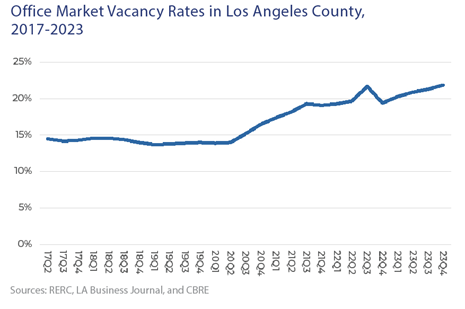
Conclusion
As Los Angeles looks to the future, it’s clear that the path to economic resilience and growth involves tackling the intertwined challenges of population decline, housing affordability, and the business environment. By embracing innovative solutions and strategic investments, Los Angeles can set the stage for a prosperous and equitable future, ensuring its position as a vibrant and resilient economic hub.